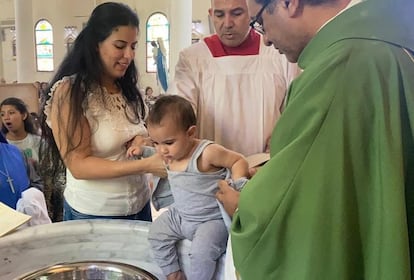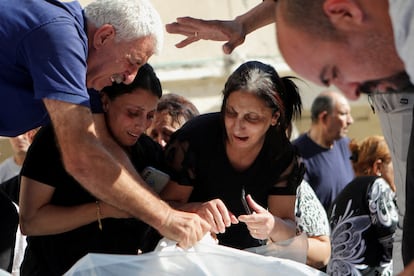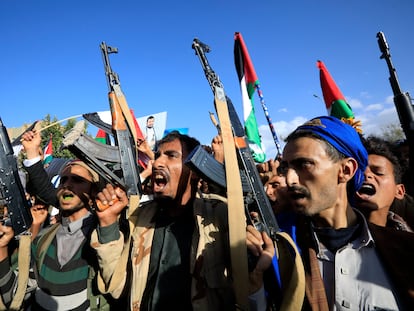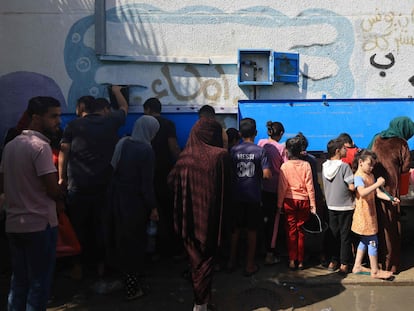The last Christians in Gaza lock themselves in a church to avoid bombs and exile: ‘Our place is here’
Several hundred worshipers are taking refuge in two churches, which have been stock piled with supplies. One of them, however, was hit by an Israeli attack

While tens of thousands of Palestinians in the Gaza Strip fled to the south of the enclave after the Israeli army’s ultimatum, hoping to get away from the bombings, a group of Christian refugees in the Catholic Church of Gaza City celebrated the baptism of an 11-months-old child named Daniel. The image from last October 15 was meant to be a message to the world. “We choose life, despite being surrounded by death,” says George Antone, the head of the NGO Caritas Jerusalem in the Gaza Strip. His voice breaks when he remembers that moment. He is exhausted and terrified, he admits in a telephone conversation with this newspaper.
“We are scared to death. Most people think that we will not come out of the church alive, that they are going to bomb us. But you have to continue, you have to be strong. We are in Jesus’ house, we are in his hands,” he says from the Holy Family Church in Gaza City.
Among the more than two million inhabitants of the Gaza Strip, there is a tiny Christian community of about 1,000 people. It’s been in decline over the years, especially since the Islamist movement Hamas took control of Gaza in 2007. Like other Gazans, they suffer from the isolation and lack of freedom of Israel’s 16-year-long blockade. But the Christians also have to deal with being excluded from work and society, which is pushed by sectors linked to Hamas and other radical Islamists movements present in the area.
“Unfortunately, we have a lot of experience in wars and when we saw the Hamas attack on the 7th [of October] we knew there would be a huge Israeli military response. My wife, my three daughters and I decided to take refuge in the church. Little by little, more people arrived who were afraid in their homes or who had lost everything. Now 500 Christians are here,” explains Antone, 42, slowly. An Egyptian priest, Father Yussef, and around a dozen nuns from different congregations have joined the group. Everyone knows that they are at enormous risk and even the most optimistic felt discouraged last Thursday, when the Greek Orthodox church, Church of Saint Porphyrius, located a few meters from theirs, was hit in a bombing which killed at least 18 of the 350 people who had taken refuge inside.
The Christian community of the Gaza Strip — aware that the area was a powder keg waiting to explode — created a management committee for future crises a few months ago and began to prepare for difficult times, explains Antone. “We began to stockpile mattresses, blankets, hygiene products, fuel and non-perishable food, prepare generators and saw how we could quickly buy water and other supplies in case of emergency. We live here and we know the situation. We feared that something was going to happen because in Gaza violence is cyclical, although this has exceeded our worst fears,” he acknowledges.
When the Israeli army warned the civilian population that they had to move to the southern part of the enclave to save their lives, the vast majority of Christian families decided not to move from the church. “Right now, we can last up to two months in here. The idea is to guarantee the survival of the Christian community in Gaza when the war ends. We don’t want to be forced to leave here, our place is in Gaza,” explains Antone, who was born into a family of Palestinian refugees in Lebanon and returned to the Gaza Strip in 1994, encouraged by the optimism triggered by the Oslo Accords and hoping to participate in the construction of a Palestinian state.
“We are all Palestinians”
“Sorry, we are in the middle of evacuating people from the Orthodox Church. We’re going to have to talk later,” Nisreen Antone, George’s wife and head of the projects of the Patriarchate of Jerusalem in Gaza, answers the phone, agitated, hours after the bombing of the Church of Saint Porphyrius, the oldest in Gaza. “We don’t know how many people have died, we believe there are people still under the rubble. There are no words to express how we feel today,” adds the woman.

Hours later, 18 Christians who died in this bombing were buried. A total of 40 survivors and several injured people are now being sheltered in the Holy Family Church, where there are doctors and nurses among the refugees. The Antone family insists that the ecclesiastical authorities in Jerusalem have informed the Israeli army that the churches and their associated institutions, such as Catholic schools, are shelters for hundreds of people, “people of peace who have nothing to do with this conflict.”
“But we are all Palestinians, there is no difference between Muslim Palestinians and us. We are not an exception, and we are permanently in danger. We’re just trying to survive, but we don’t know what’s going to happen, what the days ahead hold for us,” says Antone with anguish.
The Greek Orthodox Patriarchate of Jerusalem harshly denounced the attack and stressed that attacking a church as a military target, when it is also “providing shelter to innocent citizens” who lost their homes, “is a war crime that cannot be ignored.” An Israeli army spokesman told Reuters that its fighter jets attacked a “command post of a terrorist organization” and “a wall of a church in the area was damaged.” It reported that the “incident is being reviewed.”
A fragile balance
For years, Christians in Gaza have been maintaining a fragile balance between the Islamist authorities of the Gaza Strip, dialogue with Israel and the preservation of their customs. There have been times when the church and its followers, easily identifiable by their surnames and appearance, especially women, were the object of threats and some attacks. In the past, Christians also held important positions in the government, universities and Palestinian organizations, but they have gradually disappeared from public life in Gaza and in the best of cases they work in Catholic organizations such as Caritas or other NGOs. Unlike the large Christian families of the West Bank, who are often influential, have no financial difficulties and are well integrated into society, being a Christian in Gaza involves a complicated and daily path of obstacles.
As a result, many have packed their bags. In 2007, there were about 7,000 Christians in the Gaza Strip, seven times the current number. In all the Palestinian territories, the community does not account for more than 2% of the population. Within the Christian community of Gaza, there are no more than 130 Catholics.
Everyday life inside the Holy Family Church is perfectly organized to ward off the feeling of chaos and to drown out the fear. There are two Masses, one in the morning and one in the afternoon, praying with the rosary, moments to cook and clean... “We hardly go out because that means risking our lives. Only if it is necessary to get some medicine that we do not have or to care for someone who is in our schools, where we have received some Muslim families,” explains Antone.
When there is a threat of bombing nearby, those responsible for security inside the church quickly organize those present, help them move to one of the shelters that have been set up in safer areas of the church, where there is also water and food, and they take care of the children, the elderly and the disabled in the group.
For George Antone, one of the few moments of peace these days have been the three calls made by Pope Francis: “He was concerned about the community, in how we were living within the church, and he wished that we could return to our homes soon. Hopefully”.
Sign up for our weekly newsletter to get more English-language news coverage from EL PAÍS USA Edition









































